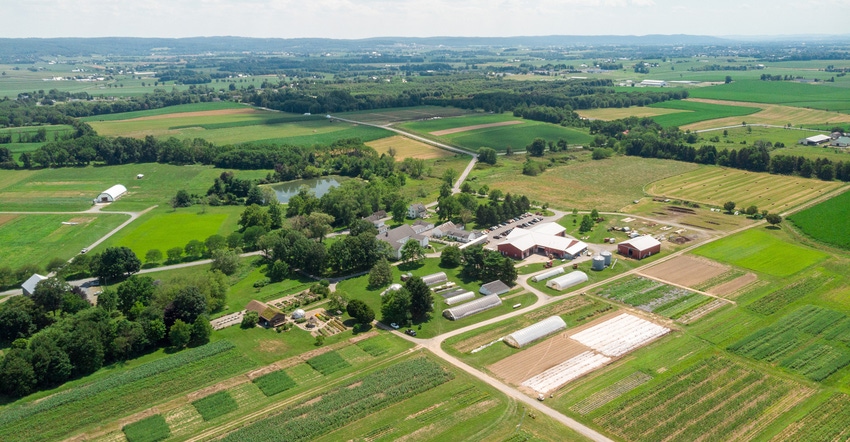May 4, 2021

In organic grain growing systems, tillage often is the go-to tool for getting ready to plant and reducing weed pressure since conventional herbicides are not allowed.
And the soil health benefits from reduced tillage have been studied and analyzed many times over. But is organic no-till a possibility? The Rodale Institute is trying to answer this question.
“Tillage has been around a long time and has been used thousands of years,” says Yichao Rui, research director of Rodale’s Farming Systems Trial.
Rui is working with USDA on a multistate, multifarm trial that’s looking at the ideal organic no-till system that not only brings environmental benefits, but also maintains yield.
The introduction of tools such as the roller crimper and planting cover crops has proven helpful in trying to solve the organic no-tool puzzle.
“Cover crops form a weed barrier that can control weeds,” Rui says. “In the fall, we plant an annual cover. It survives the winter and grows a lot of biomass. Then in spring or summer, we terminate the cover mechanically and plant a cash crop into the residue. Farmers don’t need to use herbicide or tiling to suppress weeds.”
Rodale’s Farming Systems Trial, begun in 1981, initially evaluated a conventional corn-soybean rotation to an organic corn-soybean-cover crop legume rotation with organic manure used as a source of nutrition. In 2008, a no-till versus till component was added. The trial was done to evaluate the amount of soil carbon in the soil.
“Adding no-till did not improve soil carbon in chemical-based, simplified or conventional systems, even when a cover crop is added,” Rui says. “In the organic systems, we can see that adding no-till can help further increase the soil organic carbon. In a conventional system, not tilling doesn’t necessarily improve soil organic carbon.
"It’s often still very simplified just growing corn and soybeans. There’s no diverse carbon input compared with organic systems. When you adopt completely no-till in conventional, you tend to use more herbicide and chemicals, which can have a negative effect on soil organic carbon.”
Evaluating organic no-till
Nine farms and research stations in Pennsylvania, Wisconsin and Iowa are involved in the three-year project that runs through this season.
The researchers are evaluating the effectiveness of various organic no-till systems in terminating cover crops, suppressing weeds, increasing soil nutrients and maintaining yield. The researchers also hope to evaluate the effects of various management practices on soil health.
Cereal rye is the cover crop used “as it grows a lot of biomass,” Rui says. “We need a lot of biomass to provide cover to suppress weeds among soybeans.”
The researchers have learned that plowing followed by cultivating “is a pretty destructive way to treat your soil, but unfortunately, a lot of organic farmers use this system because they cannot spray to control weeds.”
The Dawn roller, a modified roller crimper, uses hydraulics to adapt to uneven fields. Rui said that among the no-till systems being evaluated, the Dawn roller offered the best cover crop kill.
Mowing and tedding can spread the cover crop residue in the field. The researchers planted soybeans into the residue. For farmers lacking a crimper, mowing and tedding can save them the cost of buying additional equipment.
“Mow and ted can kill the cover crop 100%,” Rui says. “Sometimes it’s very difficult to spread it evenly in the field. In some places, there is no good weed control. If it’s very thick, it’s a problem for the soybean seeds to come out.”
The Rodale roller or crimper can be filled with water to increase its weight. Its use resulted in lower weed pressure.
When comparing 2019 to 2020, Rui says the researchers saw better cover crop kill in 2020, largely because of the drought in the second year, which meant much less biomass produced.
“Efficacy of cover crop termination is judged by cover crop bounce back,” he says. By mid to late summer of last year, the ongoing drought contributed to a lack of vigor.
In both years, the plowed and cultivated plots showed a few weeds, but none in the rolled and crimped fields.
“Because of the large weed pressure, the tillage treatment did not achieve the county averages,” Rui says. “Some of the no-till did.”
He adds that weed pressure varied by both year and the treatments, but “the close relationship between weed pressure and soybean yield is consistent between years. If you have more weeds, you tend to have lower soybean yield. If you want good soybean yields, you have to control weeds in the organic system.”
The weather also affected the biomass of the cereal rye. The wet winter and early spring of 2019 contributed to low biomass, high weed pressure and low soybean yields. In 2020, the low biomass and low weed pressure meant better yields.
“Our organic farmers need to work with the extreme weather,” Rui says.
The researchers also found lower nitrate in no-till soils, a result that Rui says did not surprise him, but “we need more data to make conclusions on soil health,” he adds. “That’s why long-term studies are very important to understand the impact on soil health long term.”
Sergeant writes from central New York.
About the Author(s)
You May Also Like




